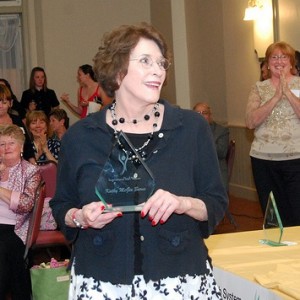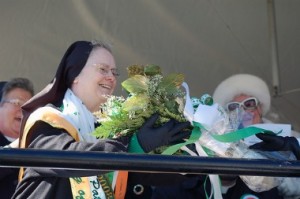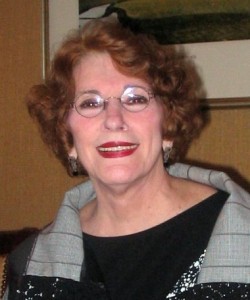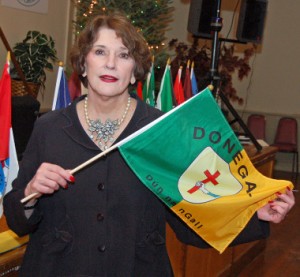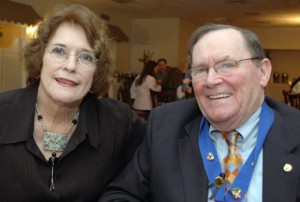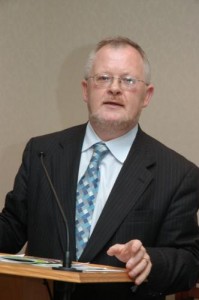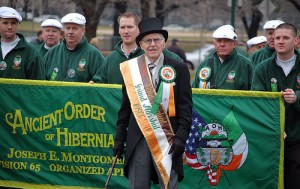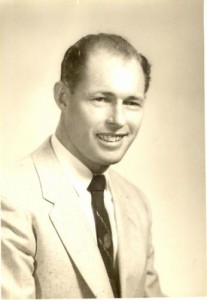On Sunday, March 13, when Kathy McGee Burns officially presides over the Philadelphia St. Patrick’s Day Parade, as only the second female president since its 1771 debut, she is going to have some very special guests marching with her.
The little girl who grew up in the Philly suburbs with no knowledge of her Irish roots is now the woman leading the parade. And joining her will be her McGee cousins from Donegal.
That moment has been a lifetime in the making. Because the same father who instilled in McGee Burns the belief that she could be anything she wanted, do anything she put her mind to, was the equal to anyone … was the same father who, like so many of his generation, denied his own Irish-ness.
“It’s incredible to me,” McGee Burns marveled. “I see my whole life as a journey. I don’t know how I got here, but I did.
“I always had this draw to being Irish …. Wondering, where was I from, where could I claim as my heritage? But my father, Timothy McGee, never talked about his family.
“He grew up very poor. His father, Hugh McGee, was the black sheep of the family. He was an alcoholic who left the family. My grandmother, Mary Jo Callahan, raised my father and his brother with the help of her mother and sisters. She cleaned houses to put food on the table.
“My father was a very well-known high school athlete, but he couldn’t pursue any of the offers he got along those lines. He had to take care of his mother and her sisters. So, he started as a clerk in the Acme. He prided himself that you could come to his counter, and he would add up all the prices in his head–this was before there were machines to do it.
“He started making bouquets of flowers to sell in the store. And from that, he built up a business as a wholesaler florist. He became a successful businessman, and created a life for his own family that was far different from the one he grew up with. He had a house at the shore, was a member of country clubs. We were very comfortable.
But he wouldn’t talk about his Irish roots.
It wasn’t until he was on his deathbed that McGee Burns was able to get a tiny clue from him about how to go about finding her family. He told her that all the relatives lived in Bridgeport: “Kathleen, every McGee in Bridgeport is related to you.”
By this time, McGee Burns was married and raising nine children of her own. And her nagging desire to acknowledge and embrace her own Irish-ness had been heightened during the dark days of the 1981 hunger strikes.
“There I was, watching Bobby Sands starve to death while my own son, Tony, who was the same age, was going to college in Chicago. I kept thinking about Mrs. Sands, how heartbroken she must have been…and how my own son was just starting his life.”
“My country, the country of my ancestors, still wasn’t free.”
McGee Burns began her journey. And her first step was to get out the phonebook and look up every McGee in Bridgeport. She sent a letter to each one of them. And she got the response she was looking for.
“Once I had enough information to trace my roots back to Donegal, I decided to join the Donegal Society. The first time I went to a meeting, I literally walked in as a stranger. They asked me who my sponsor was,” McGee Burns laughed. “I didn’t even know I needed a sponsor!”
But from that inauspicious beginning, she went on to become the first female president of the Donegal Society. And she continued on her path to discover exactly where she came from.
On a trip to Donegal about 10 or 12 years ago, a friend had a surprise for her. He told her, “I found someone who can help you find your roots. We have an appointment with him at Gallagher’s Hotel in Letterkenny at 1:00.”
Kathy won’t forget that moment: “A man came walking towards me. He looked just like my brother. He said, ‘Hi, my name is Hughie McGee. Does that name sound familiar to you?’ Well, my brother, my uncle, my nephew, my grandfather and my great-grandfather were all Hughie McGees. We sat down and did a study of our families. We both had a great-great grandfather named Cornelius McGee. His Cornelius McGee married a Kate Cannon; mine married a Kate Brogan. We had all these similarities, but couldn’t pinpoint where our families intersected.”
It wasn’t until this past summer that DNA was able to accomplish what a paper trail had failed to do: prove beyond a doubt that these two McGee families are closely related. The McGees from Gweedore, County Donegal, donated their DNA for comparison with McGee Burns’ own brother Hughie, and with the results, a once lost heritage was reclaimed.
The circle will be made complete on March 13, when Hughie McGee, his brother Paul McGee and wife Noreen, and nephew Paul McCool and wife Roisin join Kathy McGee Burns and her family, including her brother Hughie, in the St. Patrick’s Day Parade.
“Someone has been directing this from somewhere–either from up above, or down below,” McGee Burns laughed. “But the feeling I will have as I march up that aisle to address the congregation at St. Patrick’s Church for the parade Mass will be for every McGee and every Callahan that came before me.
“I represent a culmination of all their dreams, hopes and wishes. We are all going to be in that Church together. And I’ll be saying ‘thank you’ to all my Donegal ancestors.”

